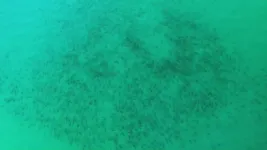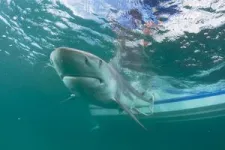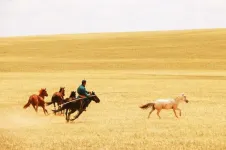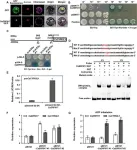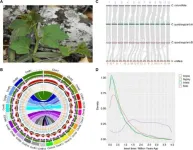(Press-News.org) When scientists want to study the long-distance movement of marine animals, they will instrument them with a small device called an acoustic transmitter – or tag – which emits unique signals or “pings.” These signals are picked up by receivers anchored to the seafloor that record the date and time of each detection when the tagged animal comes within range.
Data collected by the receivers are stored until they are retrieved by researchers and shared across members of cooperative acoustic telemetry networks. This information provides valuable insights into animal behavior, migration patterns, habitat preferences and ecosystem dynamics – all of which are vital for conservation and wildlife management efforts.
However, this method is not without limitations. Receivers must be physically retrieved to access the data they have collected. For use in marine animals, receivers are often placed near the coast for easy access, but the distribution of receivers can be uneven, with some areas having few receivers and others having many. This can lead to biased data collection, especially for animals that move across large distances.
A pioneering study by researchers at Florida Atlantic University and the Smithsonian Environmental Research Center addresses these limitations by filling in the gaps in sporadic detection data and tackles the tradeoff between spatial coverage and cost. Using a movement model, researchers reconstructed animal tracks and leveraged an iterative process to measure the accuracy and precision of these reconstructions from acoustic telemetry data.
Results of the study, published in the journal Methods in Ecology and Evolution, demonstrate how researchers can apply these techniques and measure the accuracy and precision of the methods to their study sites.
For the study, researchers simulated animal tracks on a computer, then tested how well their method could accurately reconstruct the tracks if they received detection data only from a cooperative acoustic telemetry array. While most of the data used were simulated, they further tested their methodology with data from highly migratory blacktip sharks (Carcharhinus limbatus) to demonstrate how this method can be applied ecologically.
Findings demonstrate that their novel method can improve track reconstruction, even in regions with uneven receiver coverage. The track reconstruction methods performed well in coastal regions from Palm Beach County to Long Island, minimizing the clustering effect of high densities of receivers and closing the gaps in some regions that were lacking receiver coverage. Performance was primarily affected by the presence or absence of receivers, and to a lesser extent by receiver density and water depth, depending on the grid resolution.
“Our approach could significantly reduce gaps in data collection and improve the reliability of ecological insights,” said Beth Bowers, Ph.D., senior author and a post-doctoral researcher at the Smithsonian Environmental Research Center, who conducted the research as a Ph.D. student with her mentor, Stephen Kajiura, Ph.D., in FAU’s Charles E. Schmidt College of Science. “Importantly, this method doesn’t rely on costly field techniques such as motorboat towed tests, which makes it suitable for large-scale studies across diverse habitats.”
This new method increases the utility of acoustic telemetry technology and provides a framework for future studies to assess the accuracy and precision of animal movement calculated from track reconstructions that use acoustic telemetry.
“Results from our study will enable resource managers and others to infer the reliability of ecological results in their decision-making processes,” said Kajiura, co-author and a professor of biological sciences, FAU College of Science.
To foster collaboration and innovation, the researchers have made their data repository accessible, empowering fellow scientists to adapt and apply the methodology to their respective study organisms and habitats, whether that encompasses marine, freshwater or terrestrial habitats.
“Importantly, implications of our findings extend beyond marine environments, offering a transformative approach to wildlife monitoring across aquatic and terrestrial landscapes,” said Bowers.
This work was funded by the Colgan Foundation.
- FAU -
About Florida Atlantic University:
Florida Atlantic University, established in 1961, officially opened its doors in 1964 as the fifth public university in Florida. Today, the University serves more than 30,000 undergraduate and graduate students across six campuses located along the southeast Florida coast. In recent years, the University has doubled its research expenditures and outpaced its peers in student achievement rates. Through the coexistence of access and excellence, FAU embodies an innovative model where traditional achievement gaps vanish. FAU is designated a Hispanic-serving institution, ranked as a top public university by U.S. News & World Report and a High Research Activity institution by the Carnegie Foundation for the Advancement of Teaching. For more information, visit www.fau.edu.
END
Some say the next step in human evolution will be the integration of technology with flesh. Now, researchers have used virtual reality to test whether humans can feel embodiment—the sense that something is part of one’s body—toward prosthetic “hands” that resemble a pair of tweezers. They report June 6 in the journal iScience that participants felt an equal degree of embodiment for the tweezer-hands and were also faster and more accurate in completing motor tasks in virtual reality than when they were equipped with a virtual human hand.
“For our ...
About The Study: In this cohort study of U.S. Hispanic or Latino and non-Hispanic adults, lower moderate to vigorous physical activity levels were associated with cardiovascular disease or mortality among participants with normoglycemia but not participants with prediabetes. Adults with prediabetes may benefit from reducing sedentary behavior and improving multiple lifestyle factors beyond improving moderate to vigorous physical activity alone.
Corresponding Author: To contact the corresponding author, Robert C. Kaplan, Ph.D., email robert.kaplan@einsteinmed.edu.
To ...
About The Study: A positive association between cardiovascular disease mortality and heavy lifetime cannabis use was observed among females in this study. Longitudinal studies are needed in general populations to investigate the potential effects of cannabis on mortality.
Corresponding Author: To contact the corresponding author, Alexandre Vallee, M.D., Ph.D., email al.vallee@hopital-foch.com.
To access the embargoed study: Visit our For The Media website at this link https://media.jamanetwork.com/
(doi:10.1001/jamanetworkopen.2024.15227)
Editor’s Note: Please see the article for additional information, ...
1. An international research team sequenced the genomes of hundreds of horse archaeological remains to track the historical rise of horse-based mobility around 4200 years ago in the Pontic-Caspian steppes.
2. The emergence of improved breeding techniques at the time considerably enhanced the yearly capacity of horse production, which helped spreading domestic horses like a wildfire across the whole Eurasian continent.
3. The massive human migrations that spread Indo-European languages outside the steppes around 5,000 years ago were not mediated by horses, contrarily to what was previously thought.
All domestic horses living on the planet today, whether racetrack ...
Low-income Black and Hispanic stroke survivors with uncontrolled hypertension had a more than two-fold reduction in blood pressure when they tracked it at home and sent their readings to a nurse case manager. The gains were in systolic blood pressure specifically at one year into the study and when compared to a similar group of patients who did not have access to a nurse.
Led by researchers at NYU Langone, the study is the first to examine differences in home blood pressure monitoring with or without nurse case management. Further, the findings, published online June 6 in the Journal of the American Medical Association (JAMA), addressed controlling hypertension in low-income ...
Two independent studies by Columbia scientists suggest that research into the gut’s stem cells over the past 15 years has been marred by a case of mistaken identity: Scientists have been studying the wrong cell.
Both studies were published online today in the journal Cell.
The gut’s stem cells are some of the hardest-working stem cells in the body. They work continuously throughout our lives to replenish the short-lived cells that line our intestines. About every four days, these cells—covering a surface about the size of a tennis court—are completely replaced.
Understanding these workaholic stem cells could help scientists turn ...
SCIENCE
Professor Eske Willerslev, Professor of Evolutionary Biology at the University of Copenhagen and Prince Philip Professor at the University of Cambridge, has been selected as the winner of the Albert Einstein World Award of Science 2024.
The prize is granted in recognition of the numerous breakthroughs in evolutionary genetics Prof. Willerslev’s has made during his highly fruitful career. The award recognizes his pioneering contributions in establishing the field of Environmental DNA and the sequencing of ancient DNA to track the origins and interactions of human population groups.
During his doctoral studies, Prof. Willerslev published ...
A recent study has pinpointed two key enzymes in Citrus sinensis that play a crucial role in the plant's defense mechanism against the Asian citrus psyllid (ACP), a vector for the lethal huanglongbing (HLB) disease. This research offers a promising lead in the battle against a disease that has caused significant losses in the citrus industry.
The citrus industry faces major challenges from Huanglongbing (HLB) disease, transmitted by the Asian citrus psyllid (ACP). Traditional control methods are often ineffective and environmentally harmful. The need for innovative and sustainable pest management strategies is ...
In a recent study, scientists have unlocked the genetic secrets of Cissus quadrangularis, a plant that flourishes in the harshest of desert climates. The discovery of its adaptive traits and the Crassulacean acid metabolism (CAM) pathway marks a significant leap forward in the quest for drought-resistant crops.
As water scarcity looms as a major threat to global ecosystems and food production, the quest to understand how plants like Cissus quadrangularis conquer arid landscapes is more critical than ever. The genetic blueprint of such species could hold the key to enhancing ...
(WASHINGTON, June 6, 2024) – Patients with atrial fibrillation (Afib) who took low doses of blood-thinning medications known as direct oral anticoagulants (DOACs) experienced more bleeding episodes during the first three months of treatment and about one in five had high blood levels of the medications, compared with similar patients who took standard doses of the same medications, according to a study published in Blood Advances.
Patients with Afib, a common type of arrhythmia, or ...
